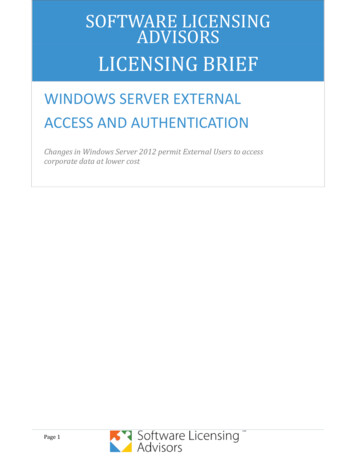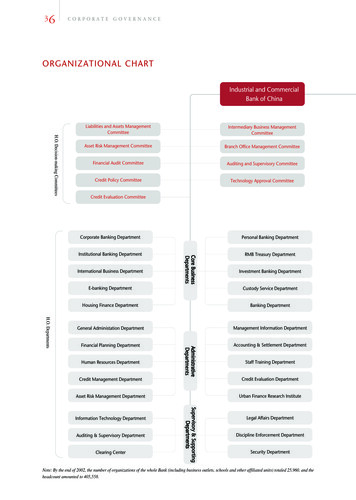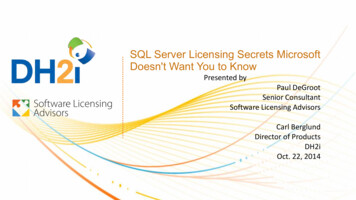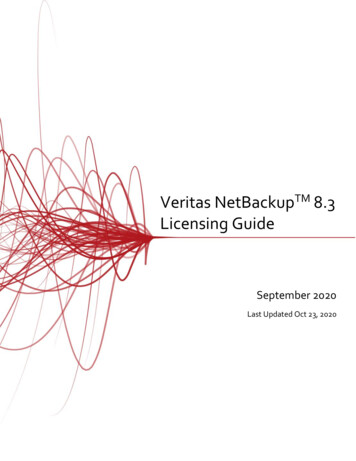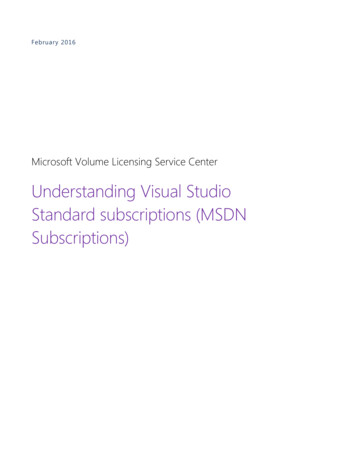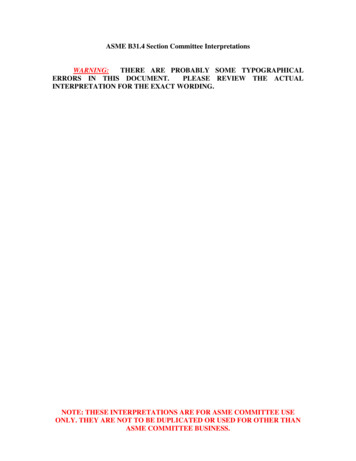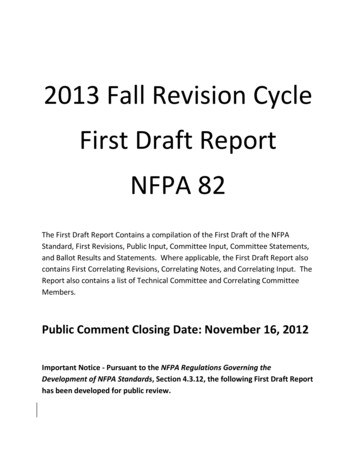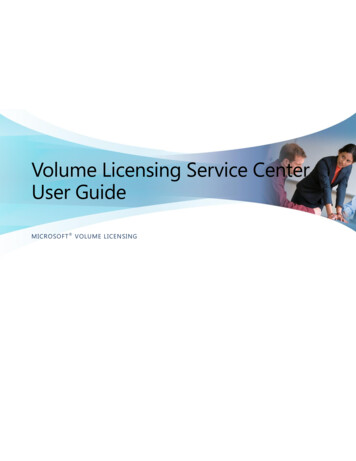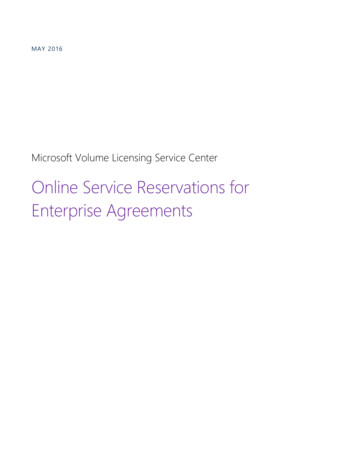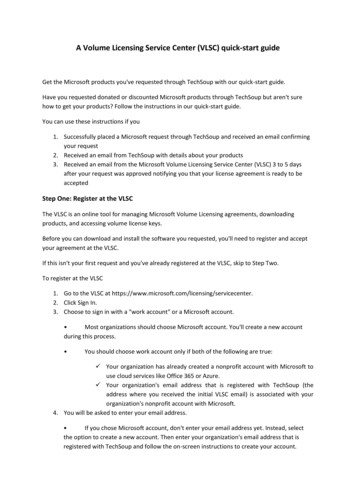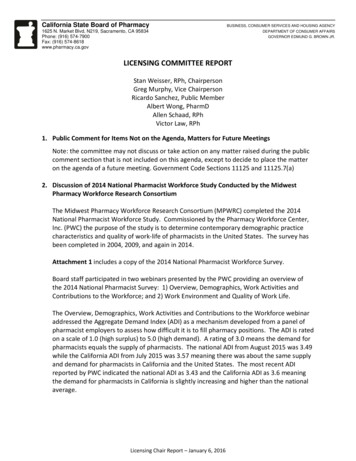
Transcription
California State Board of PharmacyBUSINESS, CONSUMER SERVICES AND HOUSING AGENCY1625 N. Market Blvd, N219, Sacramento, CA 95834Phone: (916) 574-7900Fax: (916) 574-8618www.pharmacy.ca.govDEPARTMENT OF CONSUMER AFFAIRSGOVERNOR EDMUND G. BROWN JR.LICENSING COMMITTEE REPORTStan Weisser, RPh, ChairpersonGreg Murphy, Vice ChairpersonRicardo Sanchez, Public MemberAlbert Wong, PharmDAllen Schaad, RPhVictor Law, RPh1. Public Comment for Items Not on the Agenda, Matters for Future MeetingsNote: the committee may not discuss or take action on any matter raised during the publiccomment section that is not included on this agenda, except to decide to place the matteron the agenda of a future meeting. Government Code Sections 11125 and 11125.7(a)2. Discussion of 2014 National Pharmacist Workforce Study Conducted by the MidwestPharmacy Workforce Research ConsortiumThe Midwest Pharmacy Workforce Research Consortium (MPWRC) completed the 2014National Pharmacist Workforce Study. Commissioned by the Pharmacy Workforce Center,Inc. (PWC) the purpose of the study is to determine contemporary demographic practicecharacteristics and quality of work‐life of pharmacists in the United States. The survey hasbeen completed in 2004, 2009, and again in 2014.Attachment 1 includes a copy of the 2014 National Pharmacist Workforce Survey.Board staff participated in two webinars presented by the PWC providing an overview ofthe 2014 National Pharmacist Survey: 1) Overview, Demographics, Work Activities andContributions to the Workforce; and 2) Work Environment and Quality of Work Life.The Overview, Demographics, Work Activities and Contributions to the Workforce webinaraddressed the Aggregate Demand Index (ADI) as a mechanism developed from a panel ofpharmacist employers to assess how difficult it is to fill pharmacy positions. The ADI is ratedon a scale of 1.0 (high surplus) to 5.0 (high demand). A rating of 3.0 means the demand forpharmacists equals the supply of pharmacists. The national ADI from August 2015 was 3.49while the California ADI from July 2015 was 3.57 meaning there was about the same supplyand demand for pharmacists in California and the United States. The most recent ADIreported by PWC indicated the national ADI as 3.43 and the California ADI as 3.6 meaningthe demand for pharmacists in California is slightly increasing and higher than the nationalaverage.Licensing Chair Report – January 6, 2016
The webinar also provided characteristics of the pharmacists’ practice settings andactivities. For example, there has been in increase in hospital setting practices, otherpatient care settings, and non‐patient care settings. While the MPWRC was unclear as towhat was causing this trend, it was attributed to possibly less positions in the communitysetting or pharmacists selecting different practice settings. From the 2009 to 2014 survey,the time a pharmacist spends on patient care services/non‐medication provision increasedwhile the time spent on patient care services/medication dispensing decreased. Time spenton management, research and education remained approximate the same.The Work Environment and Quality of Work Life webinar focused more on qualitative issuesimpacting the work life a pharmacist. From 2009 to 2014, pharmacists realized an increasein the restructuring of pharmacists’ work schedules; early retirement incentives; mandatoryreduction of pharmacists’ hours; and pharmacists’ layoffs. Additionally, from 2009 to 2014,the ratings of workload being rated as “high” or “excessively high” decreased for theindependent, supermarket, hospital and other patient care settings while ratings increasedin chain, mass merchandiser, and other non‐patient care settings.Further, there was an increase in the percentages of pharmacists reporting currentworkload as having a “negative” or “very negative” effect on items such as: jobperformance; work motivation; job satisfaction; mental health; physical health; takingadequate breaks; and time spent in contact with patients. These increased in percentagesfrom the 2004 to the 2009 survey and again in 2014. The survey noted no change in thisrating for the quality of care provided to patients in 2004, 2009, or 2014. Overall, jobsatisfaction decreased from 2009 to 2014 in independent, chain, mass merchandiser,hospital and other patient care settings. However, job satisfaction increased insupermarket and other non‐patient care settings.The 2014 survey highlights a changing and dynamic health care profession. Noted is thecapacity for contributing in new and exciting areas of health care never before ventured.However, the importance of implementation and impact on the pharmacists will beinvaluable in future transitions.3. Discussion of Pharmacy Technician Licensure Requirements and Practicea. Pharmacy Technician Duties and Functions. The Board may discuss the functions, rolesand responsibilities of the pharmacy technician as well as possible changes.Business and Professions Code section 4115 specify that a pharmacy technician mayperform packaging, manipulative, repetitive or other nondiscretionary tasks, only whileassisting, and while under the direct supervision and control of a pharmacist. Further,Title 16 California Code of Regulations section 1793.2, specifies specific duties that maybe performed by a pharmacy technician, as listed below.Licensing Chair Report – January 6, 2016Page 2 of 13
Removing the drug or drugs from stock Counting, pouring, or mixing pharmaceuticals Placing the product into a container Affixing the label or labels to the container Packaging and repackagingb. Discussion of the Evaluation for the PTCB and ExCPT Examinations by the DCA Office ofProfessional Examination ServicesThe Department of Consumer Affairs’ Office of Professional Examination Servicesconducted a comprehensive review for the Pharmacy Technician Certification Board’s(PTCB) Pharmacy Technician Certification Exam (PTCE) and the National HealthcareerAssociation’s (NHA) Exam for the Certification of Pharmacy Technicians (ExCPT).Attachment 2 includes a copy of report completed by Office of Professional ExaminationServices.c. Presentation by the National Healthcareer Association (NHA) on the ExCPT Examinationand Its Pharmacy Technician Workforce StudyThe National Healthcareer Association (NHA) administers the Exam for the Certificationof Pharmacy Technicians (ExCPT). NHA will provide an overview of the ExCPTexamination, to include information regarding prerequisites for taking the examination,statistics on pass rates, comparison to the PTCB examination, and other information.Additionally, NHA will provide information on its Pharmacy Technician Workforce Study.Attachment 3 includes a copy of the NHA’s presentation that will be provided to theLicensing Committee.d. Employer Based Pharmacy Technician Training Programs and Impact of the NewAmerican Society of Health‐System Pharmacists (ASHP) Accreditation CurriculumAt this meeting representatives from two chain drugs stores will present information ontheir pharmacy technician training programs and the impact of the new AmericanSociety of Health‐System Pharmacists Accreditation Curriculum.Licensing Chair Report – January 6, 2016Page 3 of 13
e. Pharmacy Technician Qualifications and Requirements for Licensure. The board maydiscuss current qualifications and requirements for licensure as well as possible changes.Relevant LawBusiness and Professions Code section 4038 defines a pharmacy technician as anindividual who assists a pharmacist in a pharmacy in the performance of his or herpharmacy related duties, as specified.Business and Professions Code Section 4202 establishes the general requirements for anapplicant seeking licensure as a pharmacy technician.Title 16 CCR Section 1793 provides additional context to the definition of a pharmacytechnician including the duties that are performed (packaging, manipulative, repetitiveor other nondiscretionary tasks related to the processing of a prescription in apharmacy) under the direct supervision and control of a pharmacist.Title 16 CCR 1793.2 further details the nondiscretionary tasks including: Removing the drug or drugs from stock Counting, pouring, or mixing pharmaceuticals Placing the product into a container Affixing the label or labels to the container Packaging and repackagingTitle 16 CCR 1793.5 provides the application requirements for a pharmacy technicianlicense including: Identifying information Description of qualifications and supporting documentation Criminal background check Self‐Query from the National Practitioner Data BackTitle 16 CCR 1793.6 provides the requirements for acceptable training courses as one ofthe pathways to licensure as a pharmacy technician licensure. Training program accredited by the American Society of Health‐System Pharmacists(ASHP) Training program provided by a branch of the federal armed services Course that provides training period of at least 240 hours of instruction coveringspecified areas of pharmacy practice.Licensing Chair Report – January 6, 2016Page 4 of 13
Title 16 CCR 1793.7 establishes the requirements for pharmacies employing pharmacytechnicians. The section includes provisions that the supervising pharmacist is fullyaware of all activities of a pharmacy technician under his or her direct supervision.Further this section provides that a pharmacist shall be responsible for all activities ofpharmacy technicians to ensure that all such activities are performed completely, safelyand without risk to patients. This section also establishes the pharmacist to pharmacytechnician ratio.Title 16 CCR 1793.8 establishes the “technician check technician” program in acute careinpatient hospital pharmacy settings.BackgroundFor several meetings the board has discussed different facets of the pharmacytechnician program in an effort to raise the bar for pharmacy technician applicants.In September 2015, the committee made a recommendation to the board to change theminimum educational requirements for licensure. After reaching consensus that theboard wishes to increase pharmacy technician knowledge, the board in October 2015referred the review back to the committee for further vetting and discussion. Thecommittee was asked to consider various topics, to include (but not limited to)discussion on whether education level correlates to the likelihood of discipline, toreceive feedback on pharmacy technician training programs, to consider whetherincreasing requirements may have unintended consequences, and if the board shouldconsider different levels of pharmacy technician licensure (i.e., hospital, compounding,community, etc.).In the past, the committee received public feedback in support of increasing theknowledge base of pharmacy technicians, but not necessarily by increasing theminimum statutory educational requirements.During this MeetingChairperson Weisser will guide the discussion as the committee continues to assess thepharmacy technician licensure requirements and practice.Attachment 4 includes copies of the law for the above referenced sections.Licensing Chair Report – January 6, 2016Page 5 of 13
f. Frequently Asked Questions (FAQs) on Criminal Convictions That Could Result in Denialof a Pharmacy Technician ApplicationThe board’s Criminal Conviction Unit (CCU) reviews criminal offender record information(CORI) received on applicants and licensees. This unit also responds to calls fromapplicants and licensees on what impact, if any, a particular conviction or act may haveon the person’s ability to receive or maintain a license. Anecdotally, the CCU indicatesthat the majority of callers are pharmacy technician applicants and licensees.Attachment 5 contains a copy of a draft document “FAQs for Applicants with CriminalHistory” which addresses the majority of the questions this unit receives. The boardcurrently has various FAQ documents on its website for applicant references, such asFAQs for site applicants, FAQs for Pharmacy Technician Applicants, etc. Staffrecommends that the committee consider making this FAQ document available on theboard’s web site as well.g. Development of Video for Pharmacy Technician ApplicantsIn an effort to address deficiency rates of pharmacy technician applicants, the board hastried various approaches to educate applicants, and to keep the pharmacy technicianapplication up to date. To further these efforts, board staff has been working with theDepartment of Consumer Affairs to make a video designed to assist pharmacytechnician applicants with the application process.After drafting a script, the department filmed on two occasions in December; severalboard staff played roles in the video. The DCA is now in the process of completing arough cut of the video for the board’s review – the department anticipates the roughcut could be available as early as the end of January. After the board has an opportunityto see the video and provide input on the content, the video will be finalized and it willbe available to post on the board’s website and on the departments YouTube channel.h. Overview of Board Discipline of Pharmacy TechniciansAs previously reported to the committee, staff had reviewed pharmacy technicianlicenses over a four year period (FY 2011/2012 through FY 2014/2015) and found that ofthose pharmacy technicians that had been disciplined, over 80 percent had qualified forlicensure by completing a training program.Due to system limitations, the board’s electronic records cannot parse out (of the“training program qualification”) the various methods of qualification outlined in boardregulation (16 CCR 1793.5). Staff is manually pulling pharmacy technician files todetermine the type of training program the disciplined pharmacy technicians had toinitially qualify for the license and will bring the results of this review to the committee.Licensing Chair Report – January 6, 2016Page 6 of 13
Types of ViolationsBelow are charts that depict the top five (5) violations for which a pharmacy technicianlicense was revoked during the four year period. The first table differentiates which ofthe licensees qualified for the license by meeting the training course provisions specifiedin Business and Professions Code section 4202(a)(2) versus all other methods ofqualification for a license (B&PC 4202(a)(1), 4202(a)(3) and 4202(a)(4)).Top 5 Violations for Which a Pharmacy Technician License was RevokedFY 2011/12 through FY 2014/15400350300A ll Other Methods Qua lif d250200 1S0ra ining Program Quar · d[B&P 4202 (a)(2)]100so4301(1)4301 (f)301m301 (h)4301 (o)Legend: All references are to the California Business and Professions Code and all aredeemed Unprofessional Conduct.Section 4301(l) –Crime substantially related to the qualifications, functions and duties ofa licensee.Section 4301(f) – Commission of any act involving moral turpitude, dishonesty, fraud,deceit or corruption, whether the act is committed in the course of relations as alicensee or otherwise, and whether the act is a felony or misdemeanor or not.Section 4301(j) – Violation of any of the statutes of California or of any other state, or ofthe United States regulating controlled substances and dangerous drugs.Section 4301(h) – Self‐administration of any controlled substance, or the use of anydangerous drug or of alcoholic beverages to the extent or in a manner as to bedangerous or injurious to oneself, to a person holding a license under thischapter, or to any other person or to the public, or to the extent that the useimpairs the ability of the person to conduct with safety to the public the practiceauthorized by the license.Licensing Chair Report – January 6, 2016Page 7 of 13
Section 4301(o) – Violating or attempting to violate, directly or indirectly, or assisting inor abetting the violation of or conspiring to violate any provision or term of thischapter or of the applicable federal and state laws and regulations governingpharmacy, including regulations established by the board or by any other stateor federal regulatory agency.Denied ApplicantsDuring the same four year period, the board denied 295 pharmacy technicianapplicants. The chart below shows – of those denied – the method by which they wereseeking to qualify for the license.Denied Pharmacy Technician Applicants – Qualifying MethodsFY 2011/12 through FY 2014/150',00A ll OtherQuar ied80ethods60 ra in ·ng Pro ramQud [B &P 4202(a)( 2),1ar ·200FYi.1/ 1FY ll/ 13FV 13/ 4FY 14/ 5Update on the California Pharmacists Association (CPHA) and California Society ofHealth‐System Pharmacists’ (CSHP) Workgroup on Pharmacy Technician Job DutiesAt this meeting the California Pharmacists Association (CPhA) will provide an update onthe formation of a workgroup related to pharmacy technician job duties.Licensing Chair Report – January 6, 2016Page 8 of 13
4. Competency Committee Reporta. Update on the Transition to the New Content OutlineRelevant LawsBusiness and Professions Code Section 139 requires the board to complete examinationvalidation and occupation analyses.Business and Professions Code Section 4200.2 provides the general areas of assessmentthat must be included in the CPJE.BackgroundPursuant to Business and Professions Code section 139, the board is required tocomplete an occupational analysis periodically which serves as the basis for the CPJEexamination. To complete this analysis, the committee recently developed a job analysissurvey with the board’s contracted psychometric firm. The survey was offered tospecific, randomly selected California pharmacists (via postcard and a link to the board’sWeb site) in June 2014. There were 524 pharmacists who provided responses.The survey resulted in the need to slightly change the content outline of the CPJE toensure it remains valid for California. Under the leadership of the board’s psychometricconsultant, the Competency Committee revised the content outline.The new content outline will be used to develop examinations administered after April1, 2016. In order to provide for a seamless transition to the new content outline, theboard has developed a communication plan to ensure all impacted CPJE candidates aremade aware of the upcoming change.In order to facilitate implementation, the board will complete the following steps duringthe week of January 4, 2016: Update the board’s website to reflect the new CPJE Content Outline.Update the CPJE bulletin with the new CPJE Content Outline. This CPJE bulletinmailed to candidates upon approved eligibility to take the CPJE and posted on theboard’s website.Advise new eligible candidates of the new CPJE Content Outline.Contact all CPJE Candidates with open eligibilities to inform them of the new CPJEContent Outline.Contact the deans of all California Schools of Pharmacy to inform them of the newCPJE content outline.Attachment 6 includes a copy of the new CPJE Content Outline.Licensing Chair Report – January 6, 2016Page 9 of 13
b. Committee ActivitiesThe competency committee held two meetings in the fall of 2015 to continueexamination development activities as well as implement the new CPJE Content Outline.Meetings are schedule for 2016 as well.The competency committee continues to recruit for pharmacists specializing ininstitutional or community practice to serve as subject matter experts and assist theboard with examination development activities. Subject matter experts primarilyprovide development and oversight of the CPJE. The CPJE consists of 90 multiple‐choiceitems that tests competency in patient communication skills, pharmacy law and clinicalknowledge.Practicing California pharmacists licensed within the last five years are particularlyencouraged to apply to serve in this capacity. Experts generally meet five timesannually for two days session. Attendance at each meeting is crucial. Experts areapproved by the board and generally serve in this capacity for four years; however,individuals can serve in this capacity for a longer duration with approval of the board.Interested individuals are encouraged to submit an application including theircurriculum vitae, a cover letter describing the applicant’s pharmaceutical experience orpractice, and three letters of reference from pharmacists familiar with the applicant’swork. Please submit your applications to the board’s address at the attention of CPJESubject Matter Expert Recruitment.5. Status of Pending Regulations Related to the Implementation of SB 493, IncludingAdvanced Practice Pharmacist Licensure Requirements, Travel Medications,Immunizations, Nicotine Cessation, Hormonal Contraception and NaloxoneSenate Bill 493 requires that the board adopt a number of regulations, and in several cases,the board determined that promulgation of additional regulations should occur. Theboard’s efforts are aimed at completing the adoption process for the regulations as close toJanuary 2016 as possible.Below is the status of various regulations related to implementation of SB 493:Comment Periods Closed; Waiting for Full Board Review‐ Travel Medications‐ APP Licensure RequirementsUndergoing Initial 45‐Day Comment Period‐ APP Certification Requirements (Comment period closes February 8, 2016)Licensing Chair Report – January 6, 2016Page 10 of 13
Undergoing 15‐Day Comment Period‐ Self‐Administered Hormonal Contraception Protocol(Comment period closes January 14, 2016)Board Adopted and Undergoing Administration Review‐ Nicotine Replacement Products‐ Naloxone Hydrochloride Protocol (non‐emergency rulemaking)Board adopted, Comment Period Closed, Staff preparing Final Package for AdministrationReview‐ ImmunizationsCurrently in Effect‐ Emergency Regulation: Naloxone Hydrochloride Protocol6. Implementation of Legislation that Impacts the Board’s Licensing Operationsa. Assembly Bill 2605 Regarding Third‐Party Logistics ProvidersWith the passage of Assembly Bill 2605, the board began implementation of the licenseprocess for Third‐Party Logistics Providers and Designated Representatives‐3PL. Boardstaff continues to educate 3PLs and DRLs of license requirements. As referenced in thelicensing statistics (Agenda item 7) as of November 30, 2015, the board had issued thefollowing:Third‐Party Logistics Providers (TPL)Third‐Party Logistics Providers Nonresident (NPL)Designated Representatives‐3PL (DRL)1029123b. Assembly Bill 1352 Regarding Deferred Entry of Judgement and Withdrawal of PleaIn 2015, Assemblymember Eggman authored legislation that – as of January 1, 2016 –will allow a defendant who was granted a deferred entry of judgment on or afterJanuary 1, 1997, after pleading guilty or nolo contendere to the charged offense, towithdraw his or her prior guilty plea and to enter a plea of not guilty if the charges weredismissed after the defendant performed satisfactorily during the deferred entry ofjudgment period and the defendant shows that the plea may result in the denial or lossto the defendant of any employment, benefit, license, or certificate, including, but notlimited to, causing a noncitizen defendant to potentially be found inadmissible,deportable, or subject to any other kind of adverse immigration consequence.The amendments to the Penal Code will significantly impact the Board’s ability to provein disciplinary proceedings that a licensee or applicant is engaged, or has been engaged,Licensing Chair Report – January 6, 2016Page 11 of 13
in illicit drug activities. The board believes this new authority will likely increase theboard’s costs of prosecution or could lead to the dismissal of certain disciplinary charges,to the detriment of public safety.c. Senate Bill 590 Regarding Intern Pharmacist Practice Experience HoursLast year the board authored legislation that specifies that pharmacy practice experiencefor an intern pharmacist shall include 900 hours as a pharmacist in both community andinstitutional pharmacy practice settings. The bill also specifies that any student whograduated from a school accredited by the Accreditation Council for Pharmacy Educationor a board recognized school of pharmacy after January 1, 2016 shall be deemed to havemet the practice experience requirement. Since the time the bill was approved by theGovernor (August 2015) board staff has received numerous inquiries from seekingclarification of the new provisions. The provisions of the bill go into effect on January 1,2016.7. Licensing StatisticsLicensing Statistics for July 1, 2015 – November 30, 2015As of November 31, 2015, the board has 140,327 licensees, including 43,744 pharmacistsand 74,863 pharmacy technicians.The board has received 7,806 applications and issued 6,718 licenses during the first fivemonths of the fiscal year. During this same period, the board denied 43 applications. Inaddition, the board received 11,970 status inquiries via e‐mail and responded to 9,933. Theresponse numbers can be lower to account for one response to multiple emails received(i.e., the person emails once a day until they get a response). The Licensing Statistics forFiscal Year 2015/16 ending November 30, 2015, is provided in Attachment 7.Since July 2015, the board has been closely tracking the licensing unit’s processing times forvarious application types. The board continues to work with the department to developmore robust reporting reports. The department is implementing Licensing PerformanceMeasures (LMP) processing times for the boards and bureaus – and the board anticipatestesting of the draft reports in early 2016. The LPM reports will provide more detail on theboard’s processing times, deficiency rates, etc.General processing information by license type is provided below. These numbers reflectthe processing of new applications as of mid‐December. These numbers reflect the time anapplication is received by the board through the time either a deficiency letter is issued or alicense is issued. If an incomplete application is received, there will be additional processingtime involved.Licensing Chair Report – January 6, 2016Page 12 of 13
Site Application TypePharmacyNonresident PharmacySterile CompoundingNonresident Sterile CompoundingHospitalClinicWholesalerNonresident WholesalerThird‐Party Logistics ProviderNonresident Third‐Party Logistics ProviderNumber of Days424515151517171617Individual Application TypePharmacist ExamPharmacist Initial LicensePharmacy TechnicianIntern PharmacistDesignated RepresentativeDesignated Representative – 3PLNumber of Days15310111In addition, the processing time for evaluating deficiency mail is averaging between 25 daysto 50 days depending on the license type.8. Future Committee Meeting Dates for 2016The following dates have been established for future meetings:March 30, 2016May 26, 2016September 21, 2016Licensing Chair Report – January 6, 2016Page 13 of 13
Attachment 1
2014 NATIONALPHARMACISTWORKFORCE SURVEY14ISTHSi
FINAL REPORT OF THE 2014 NATIONAL SAMPLESURVEY OF THE PHARMACIST WORKFORCE TODETERMINE CONTEMPORARY DEMOGRAPHICPRACTICE CHARACTERISTICS AND QUALITY OFWORK-LIFEApril 8, 2015i
Midwest Pharmacy Workforce Research ConsortiumUniversity of MinnesotaUniversity of IowaUniversity of Wisconsin - Madisonii
Prepared by Midwest Pharmacy Workforce Research ConsortiumCaroline A. Gaither, PhD, University of Minnesota, Principal InvestigatorJon C. Schommer, PhD, University of Minnesota, Co-Principal InvestigatorWilliam R. Doucette, PhD, University of IowaDavid H. Kreling, PhD, University of Wisconsin – MadisonDavid A. Mott, PhD, University of Wisconsin – MadisonWilliam R. Doucette PhD Caroline A. Gaither PhD David H. Kreling PhDDavid A. Mott PhDJon C. Schommer PhDAdvisory CommitteeLynette Bradley-Baker, PhD, American Association of Colleges of PharmacyRonald S. Hadsall, PhD, University of MinnesotaKatherine K. Knapp, PhD, Touro UniversityLucinda L. Maine, PhD, American Association of Colleges of PharmacyDouglas Scheckelhoff, MS, American Society of Health-System PharmacistsStephen W. Schondelmeyer, PhD, University of MinnesotaProject CommissionThis current investigation was commissioned by the Pharmacy Workforce Center, Inc. (PWC). ThePWC is comprised of American Association of Colleges of Pharmacy (AACP), American College ofClinical Pharmacy (ACCP), American Pharmacists Association (APhA), American Society ofHealth-System Pharmacists (ASHP), Board of Pharmacy Specialties (BPS), Bureau of HealthWorkforce (BHW), National Alliance of State Pharmacy Associations (NASPA), NationalAssociation of Boards of Pharmacy (NABP), National Association of Chain Drug Stores (NACDS)Foundation, National Community Pharmacy Association (NCPA) and Pharmacy TechnicianCertification Board (PTCB). The American Association of Colleges of Pharmacy serves assecretariat to the PWC.Repository for Project Materials and DataProject materials and data are stored at University of Minnesota, College of Pharmacy, Department ofPharmaceutical Care & Health Systems, 308 Harvard Street, S.E., Minneapolis, MN 55455.iii
AcknowledgementsFirst, we would like to thank the nation’s pharmacists who received and responded to the survey. Weappreciate their time and effort in providing the requested information. Without their assistance, the reportwould not be possible.Second, we would like to acknowledge the contributions of several people associated with this project.We would like to thank Lucinda Maine, Lynette Bradley-Baker, and Douglas Scheckelhoff at thePharmacy Workforce Center, Inc., and Marilyn Speedie, Dean, and Ronald Hadsall, Assistant Dean,University of Minnesota, College of Pharmacy, for their tremendous support of this project, theirleadership, and their understanding of the research process and allowing for the completion of this report.Their guidance and assistance is sincerely appreciated. Katherine Knapp and Stephen Schondelmeyer alsoprovided encouragement and advice. We also acknowledge members of the Pharmacy Workforce Center,Inc., who provided support, advice and leadership throughout the project.Finally, a number of persons w
Jan 06, 2016 · conducted a comprehensive review for the Pharmacy Technician Certification Board’s (PTCB) Pharmacy Technician Certification Exam (PTCE) and the National Healthcareer Association’s (NHA) Exam for the Certification of Pharmacy Technicians (ExCPT). Attachment 2. includes a copy of
